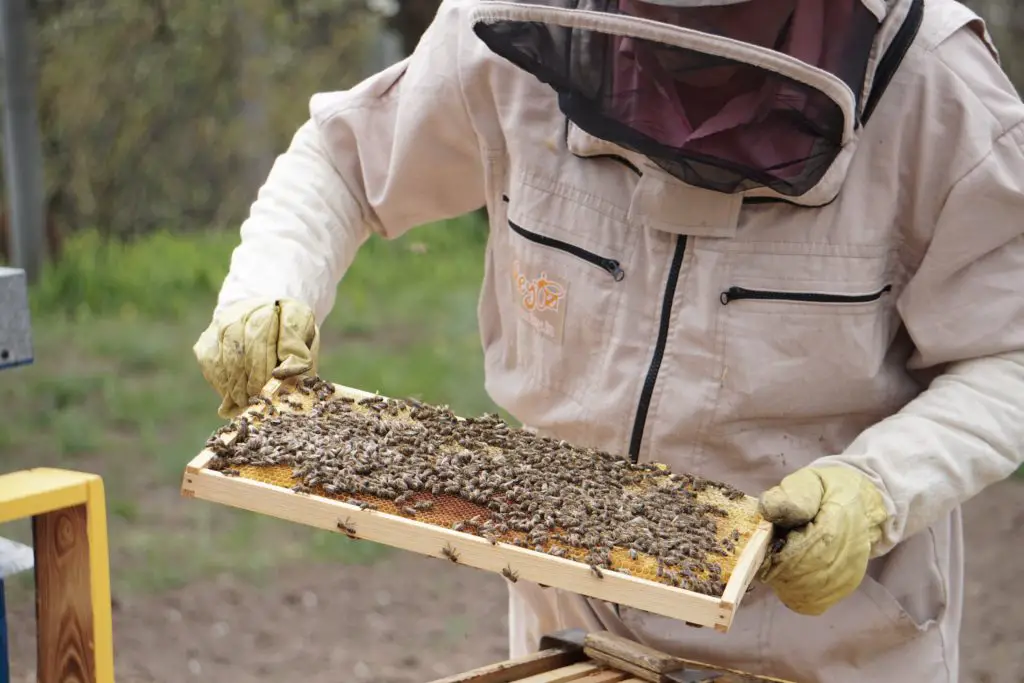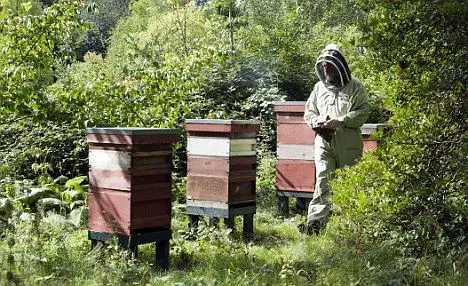Affiliate Disclaimer - As an Amazon Associate I earn from qualifying purchases.
It supports the website. So, Thank you
If you’re new to beekeeping and don’t want to make a fool out of yourself at your next apiarist meet-up then I’d guess that you want to make sure you’ve got the terminology down to a T. One of the words you’re going to see time and again is apiary but many people aren’t sure how to pronounce apiary. Don’t worry, I’ve got you covered.
Apiary is a word that’s largely pronounced how it is spelled. According to online dictionaries, the correct pronunciation is ay-pi-uh-ree
Table of Contents
What Is An Apiary?
The word apiary is used to describe an area where bees are kept. Many people confuse this term with the beehive but it’s not actually describing the individual hives, rather a collection of hives in a particular area.
Interestingly, when most people think about an apiary, they imagine a serene meadow, dotted with beehives, somewhere in the countryside. While this is certainly a correct image, it’s not the only one.
An apiary really is just somewhere that bees are kept and that could be in an urban area, a backyard, or anywhere else that you place your hives.
Where Does The Word Apiary Come From?
The word apiary, like many modern English words, actually comes from Latin. If we break the word down, it’s pretty easy to see how it gets its meaning.
Apis means bee, and this is the stem of the word Apidae which refers to the family of bees that honey bees are found in.
Initially, the word for an area where bees are kept was likely apiarium but, over time, this has been altered to the term we use today; apiary.
Locating Your Apiary: The Perfect Spot
While we’re on the subject of apiaries, I thought I would take the opportunity to give you some information on the best spot for yours.
As I mentioned earlier, many people imagine an apiary being in a quiet, rural location but there’s far more scope for placement than this.
When it comes to choosing a spot for your apiary, I’d urge you to consider the following points.
- Your bees need to have easy access to foraging sites and this should be one of your first considerations. I wouldn’t recommend placing your apiary more than 2 to 3 km from the nearest foraging sites.
- Just as important as a food source is a water source and it is strongly recommended that the bees have water within 500 meters of their hives.
- While it can be tempting to shove as many hives into your apiary as possible, this isn’t a good idea. Too many bees will result in competing colonies as food resources become scarce.
- It’s typically best to place your apiary on level ground. This isn’t so much for the bees’ benefit as it is for yours. Imagine trying to work on your hive on unlevel or steep ground; it’s just going to make life more difficult than it needs to be.
- Bees are very sensitive to the weather and as such, your apiary should be well placed to protect them from the elements. Tree cover and lots of shade is great but also be mindful of local predators and how easily they may be able to access the site.
- Finally, always aim to choose a spot that won’t cause disruption or danger to other people. Keep your apiary away from public roads and footpaths and, if you’re setting up in close proximity to your neighbors, be sure to have discussions about this before you start.
Why Are Apiaries Important?
If you’re just starting out with beekeeping then I’d always recommend setting up one hive initially. This is because it’ll give you one thing to focus on and won’t overload you. Plus, you’ll be able to really get a feel for whether beekeeping is right for you without having to invest time and money in more than one hive.
However, once you’re happy, I’d really urge you to consider keeping more than one hive and having an apiary. There are many benefits to this, including helping local farmers. Bees pollinate around 70% of all human crops so having apiaries nearby means that farmers have more success.
But this isn’t the only reason that having an apiary is beneficial. It’s not just local agriculture that will take advantage; your own beekeeping journey will be much simpler if you have more than one hive.
For example, it’s very common for bee colonies to be lost over winter since the bees struggle to provide themselves with enough honey to make it through the colder months. Having several hives means that, in the event of colony loss, you won’t need to start from scratch and the loss won’t have such a catastrophic effect.
Moreover, you’ll find that when problems occur, it’s a lot easier to address them since you’ll already have the tools and resources to do so. When people keep just one hive, they don’t normally have a vast array of equipment or resources to deal with issues and so have to waste time, effort, and money obtaining these before they can put things right.
A key example of a problem that beekeepers face is the varroa mite. This is an infestation that can quickly kill off a colony and all too frequently, beekeepers are faced with the trauma of trying to treat a single hive, only to fail. However, when you have multiple hives, while the infestation may spread, the largest hive will typically be far more resistant so there’s less chance that you’ll lose all of your bees.
It becomes much simpler to assess your colonies when you have multiple hives and this allows you to figure out which is the strongest colony. This is the colony that has the best genetics and is more easily able to resist disease, infestation, and cold weather. Once you identify this, you’ll be able to breed from that colony to create several colonies with the same genetic resistance. If you’re looking to start a beekeeping business, this is even more important.
Finally, if you have an apiary, it means less time spent on maintenance. I know a few people that have individual hives in different locations. While this can work, it does mean having to travel between the hives to perform maintenance and this takes up a lot of time. If you’re getting into beekeeping for the sheer enjoyment, you don’t want your hobby to take over other things in your life.
Interesting Apiary Facts
- Did you know that the Apiary of Inzerki is the largest apiary in the world? Located in Morocco and housing 3700 hives, it’s also considered to be the oldest apiary on the planet.
- In North America, North Dakota has the most apiaries and is considered to be the largest honey producing state in the USA.
- Countries in the North of Europe have the fewest apiaries. These include Estonia, Sweden, Latvia, Finland, Iceland, and Norway.
How To Say Apiary In Other Languages
If you’ve managed to get your head around the English pronunciation of apiary, perhaps you want to take things up a notch. Maybe you’re traveling to a beekeeping event in another country and want to impress the locals with your linguistic knowledge. Here’s how to say apiary in a few other languages.
- French – rucher
- German – bienenhaus
- Spanish – colmenar
- Russian – пасека
- Italian – apario
- Chinese – fengfang
- Hindi – madhamakkhiyon ke paalane ka sthaan
Final Thoughts
When you’re a beekeeper, there’s a lot of terminology to get your head around but it’s not just learning the meaning of these words, it’s learning how to say them. Apiary is a common stumbling block for beekeepers who aren’t sure how to pronounce apiary.
Fortunately, it’s pretty simple and the word is pronounced how it is written. The more I learn about apiaries, the more interesting I find them. I hope you’ve found this information useful in getting your very own apiary up and running.




